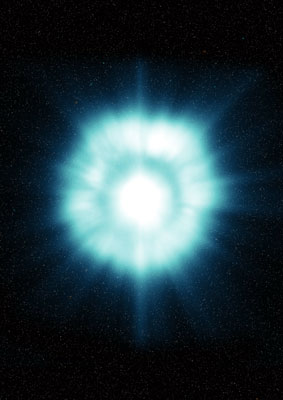[/caption]
Gamma-ray bursts (GRBs) are powerful blasts of energy that flash across the Universe. For a brief time, they are the brightest objects in the gamma-ray sky. Astronomers estimate that about 1,400 GRBs per year occur but because no one knows when and where they are going to appear, only a part of them happen to be detected. ESA's Integral gamma-ray observatory detects about 10 GRBs a year, and those are of the big burst variety. But the spacecraft has observed several low-luminosity gamma-ray bursts, confirming the existence of an entire population of weaker bursts that have hardly been noticed so far. These aren't just bursts from far away, but just weak bursts that are relatively close by. And astronomers are beginning to think these weak or faint variety of GRBs might be the most common.
When studying Integral's gamma-ray burst data, Prof. Lorraine Hanlon from the School of Physics, University College Dublin, Ireland, and her colleagues, realized that some of the faintest bursts have distinctive gamma-ray emissions, and also present faint afterglows in the lower-energy X-ray and visible wavelengths.
Since, in general, GRBs are colossal explosions of energy triggered by the collision of very massive and compact objects such as neutron stars or black holes, or by the explosion of incredibly powerful supernovae, or hypernovae, one may think that these bursts are perceived as faint just because they take place very far away from us, in the remote corners of the Universe.
However, Prof. Hanlon and colleagues noticed that these faint bursts, just at the sensitivity threshold of IBIS, seem to originate in our cosmic neighborhood, within the nearby clusters of galaxies. [caption id="attachment_19569" align="alignnone" width="400" caption="Distribution of faint GRBs. Credits: S. Foley/UCD"]
[/caption] "If the bursts we have studied are so 'close' in cosmological terms, it means that they are faint from the beginning," says Hanlon. "From this we can deduce that the processes triggering them could be less energetic than those generating the more powerful bursts we are more used to observing."
The study team suggests that the faint bursts may be generated by the collapse of a massive star that does not present the characteristics of a supernova, or by the merger of two white dwarfs (small and dense stars about the size of Earth), or by the merger of a white dwarf with a neutron star or a black hole.
"Past observations had already hinted the existence of faint GRBs, and thanks to Integral's sensitivity we can now say that an entire population of them exist," added Hanlon. "Actually, their rate may even be higher than that of the most luminous GRBs but, just because they are weaker, we may be only able to see those which are relatively close by."
"More Integral observations in the coming years will definitively help us understand the phenomenon of faint GRBs, and to explore the nature of this newly observed population," she concluded.
Source:
ESA
 Universe Today
Universe Today
